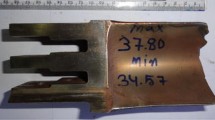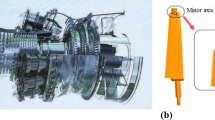Abstract
This investigation elucidates failure of a land based 6FA gas turbine compressor 2nd stage blade. During discussions with site officials, it was learnt that this particular compressor operated in good condition for over 20,000 h at two other sites. In this power station, this was second such failure with less operation duration. Due to failure of blades, it was requested for a detailed root cause analysis by the utility officials in order to avert such failures in future. Failed blade samples were collected from the site and cut into the suitable sizes for investigation procedures. Investigation techniques like visual observation, stereomicroscopic, metallographic, scanning electron microscopic examinations (SEM), etc. are employed to ascertain the root cause for failure. During the investigation it was noticed that there is no degradation in the material. During stereomicroscopic examination, a number of beach marks were observed to be present on the fractured surface of the blade. It was also noticed from both stereomicroscopic and SEM examinations that the blade failed due to fatigue. The cracks have originated from micro-cracks developed at the trailing edge during shot peening process in the blade root. These cracks grew as the blades have vibrated beyond their natural frequency due to air surge during operation. It was recommended to examine the air filtration mechanism of the compressor regularly.
Similar content being viewed by others
Avoid common mistakes on your manuscript.
1 Introduction
As per the information provided by the customer, the R2 compressor blade of 6FA gas turbine (GT) had failed and the machine was brought to the works place for repair. During first Complete Inspection (CI) after approx. 11,500 h of operation, heavy shear of R0 stage and Inlet Guide Vanes (IGV) inner side was observed. At that time, 61 Number of IGVs out of 64 were replaced. Without dressing any R0 stage and other compressor vanes, the machine was kept in service. Machine was running without any problem until 22,500 h. The unit had suffered and forced for complete revamping after completion of 22,500 h in December 2006 due to complete grid failure and both Auxiliary Oil Pump (AOP) and Emergency Oil Pump (EOP) were not started. During repair of unit rotor at manufacturing shop the following activities were carried out. (1) Replacement of compressor blades with new blades, (2) New forward stub shaft was put due to high hardness and crack at journal due to oil starvation, (3) New sleeve was fixed to bearing no. 2 and (4) Stage 16 wheel was replaced due to nonconformities to tolerance limits at shrink fit zone.
After completing all the above repairs, the unit was restarted in Feb 2008. Machine was running smoothly. Due to failure of generator at other unit, customer stopped this GT and shifted the Generator. Machine was in continuous operation till the compressor blade (R2) failure in Oct, 2011 at 46,116 Fired Hours (FH). This means, the compressor blade failure occurred at this site after 23,616 FH.
It was noted during discussions and information given by the officials concerned that the machine was running smoothly at first two sites. This machine failed at third site of the same customer. It was also learnt that this is the second such failure at this particular site. It was informed that the inlet air is purified using evaporators with cooling water sprinklers as shown in Fig. 1a. The gas turbine rotor was brought for the repair to the manufacturing unit. As decided in the meeting with customer at the site where failure occurred, the failed compressor blades (originally and consequentially) were sent to laboratory to investigate the root cause for failure. The investigations carried out on the failed compressor blade samples are discussed below.
2 Experimental Work
The originally failed and subsequently failed GT compressor blades were received and cut into pieces to make samples for various investigations viz. Visual, Stereomicroscopic, Scanning Electron Microscopic (SEM) and compatible Energy Dispersive X-Ray Spectroscopic (EDS) examinations, Chemical analysis, Mechanical testing and Hardness measurements.
2.1 Visual and Stereomicroscopic Examinations
The failed compressor blade (R2) samples were subjected to Visual and Stereomicroscopic examinations. The samples were observed with naked eye and with low power illuminated magnifying glass. The originally failed blade samples were cleaned by Ultrasonic cleaner with 2 % HCL solution and observed under Leica Z6 APO Stereomicroscope. Figure 1b shows the fracture surface failed blade in as received condition. Figure 2a, b are showing the stereo micrographs of fracture surface of the failed blade. Figure 2a shows the crack initiation region and Fig. 2b shows beach marks in the fracture surface.
2.2 Chemical Composition
One of the samples from the failed blade was sent to the manufacturing unit for chemical analysis. Chemical composition of the compressor blade sample was analyzed using Spectromax X, Optical Emission Spectrometer (OES). The chemical composition met the requirement of material, GTD450 [1].
2.3 Microstructural Examination
Two samples were cut from failed blade at root portion (base). The samples were polished and observed under optical microscope in un-etched condition for assessment of inclusion rate as shown in Fig. 3a. It was observed the inclusion rate is falling under the thin series D2 as per ASTM E45-13 standard [2] and it is within the acceptable range. Then the sample was etched (using Villella’s reagent) for obtaining microstructure. The microstructure contains lath martensite as shown in Fig. 3b and it is as per the requirement.
2.4 Hardness Measurements
After metallography, the hardness was measured on the samples using Shimadzu, HSV-30 hardness tester. The hardness is in the range of 30–37 HRC, average is about 34HRC which is in the prescribed limits (32 HRC [1]).
2.5 Tensile Testing
Tensile samples are prepared from the subsequently failed blades. Due to limitations in the availability of material, 3 tensile samples (2 from profile and 1 from base portions) are prepared from subsequently failed blade samples. Tensile tests were carried out on a 50 ton INSTRON servo hydraulic machine. The tensile test results are given in Table 1. The results are as per the standard [1].
2.6 SEM Examination and EDS Analysis
Failed compressor blade, as-received, was cut into three samples without disturbing the fracture surface features and cleaned after visual observation. All the samples were observed under SEM, Zeiss Supra 55VP. Figure 4a shows the fractograph of sample with micro cracks origin. Figure 4b shows blisters like features in shot peened area. Figure 5a shows the fractograph of 1st sample and Fig. 5b shows the corresponding EDS spectrum.
3 Results and Discussion
During visual examination of fracture surface of failed blades it was noticed that the crack had originated from trailing edge approximately 10 mm away from base and propagated towards the leading edge. Final fracture occurred towards leading edge. Beach marks are observed at a few locations on the fracture surface of originally failed blade sample. No clear features were observed on the fracture surface of consequentially failed blade. The chemical composition is meeting the requirement as mentioned in [1]. Microstructural examination shows that the structure is lath martensite with very small content of delta ferrite, which is representative of typical microstructure of GTD 450. Inclusions are also seen in the samples in un-etched condition under optical microscope. It was noticed that the inclusion rate is falling under the thin series D2 as per ASTM E45-13 standard [2] and it is within the acceptable material quality range. It is also confirmed during mechanical tests that the material is meeting all the mechanical properties.
During stereomicroscope examination, it is also noticed that the crack has initiated at the trailing edge 10 mm away from the blade base, just before end of the shot peened area and propagated further. As it is noticed that a number of beach marks are present in fracture surface of the blade indicating that the crack was initiated at trailing edge in suction side, propagated towards leading edge and failed. A number of micro cracks are noticed while scanning under SEM in the shot peened area at trailing edge on both the pressure and the suction sides. It is also noticed that the deposits are of the combination of silicates and chlorides, which is confirmed by EDS spectrum. It is also noticed from both the stereo and the SEM scanning that the blade failed due to fatigue fracture because of the cracks generated during operation. During discussions and with available information, there was no problem for the machine at the first two sites. One more specific observation is that the failure of compressor blades had occurred only at this third site. It was noticed that the air filtration mechanism as shown in Fig. 1a at this site is different from the first two sites.
During air filtration, probably sufficient amount of air might not have been fed to the compressor due to the clogging of evaporator filters located in the inlet air path. Due to insufficient amount of air, flow variation of air might have occurred leading to surge/stall. The same observation was reported by [3]. This surge/stall would have led to vibration in compressor blades beyond their natural frequency [4]. Especially R2 blades might have been affected more due to their size and natural frequency. In general, the air surge will be occurring at trailing edges of blades as surge direction is opposite to the air flow in the compressor. Moreover, the blades are having the micro cracks/blisters developed during shot peeing, which are observed during SEM examination. Since there is no alarm for vibration monitoring during operation of the machine, the heavy vibrations might not have been noticed. With the presence of micro cracks and less thickness of blades at trailing edge, the vibrations must have aided in crack initiation at trailing edge of the blade at pressure side. From the above studies and findings, it is suggested that the air filtration mechanism aided the air surge due to air starvation and lead the R2 blades to vibrate beyond their natural frequency which led to fatigue failure as observed from beach marks.
4 Conclusions and Recommendations
Based on the above findings the following conclusions are drawn:
-
Air surge has occurred due to insufficient air fed to compressor during operation. The compressor blades had vibrated beyond their natural frequency due to air surge.
-
Cracks were originated from the micro cracks developed due to shot peening at the trailing edge.
-
It is recommended to examine the air filtration mechanism, installed especially at the third site.
References
A564/A564M-13 (S45000 XM-25), Standard Specification for Hot-Rolled and Cold-Finished Age-Hardening Stainless Steel Bars and Shapes, ASTM International, USA (2013).
Standard E45-13; Standard Test Methods for Determining the Inclusion Content of Steel; ASTM International, USA (2013).
Saqib Hameed M, and Manarvi I A, “Using FEM and CFD to Locate Cracks in Compressor Blades for Non Destructive Inspections” IEEEAC paper# 1651, Version 4, Updated Nov 19 (2008).
Carole Teolis, David Gent, Christine Kim, Teolis A, Paduano J, and Bright M, Eddy Current Sensor Signal Processing for Stall Detection, IEEEAC paper #1255, Version 3, Updated Dec 10 (2004).
Acknowledgments
Authors are grateful to the management of BHEL (R&D), BHEL (HPEP) Hyderabad and BGGTS for giving the opportunity to carry out this investigation and funding this study. Authors would like to express their gratitude to the staff of Metallurgy department, BHEL (R&D) for rendering services during tensile testing and metallographic examination.
Author information
Authors and Affiliations
Corresponding author
Rights and permissions
About this article
Cite this article
Swamy, M., Singh, K., Pavan, A.H.V. et al. Failure Investigation of Frame 6FA Gas Turbine Compressor Blades. Trans Indian Inst Met 69, 647–651 (2016). https://doi.org/10.1007/s12666-015-0775-6
Received:
Accepted:
Published:
Issue Date:
DOI: https://doi.org/10.1007/s12666-015-0775-6









